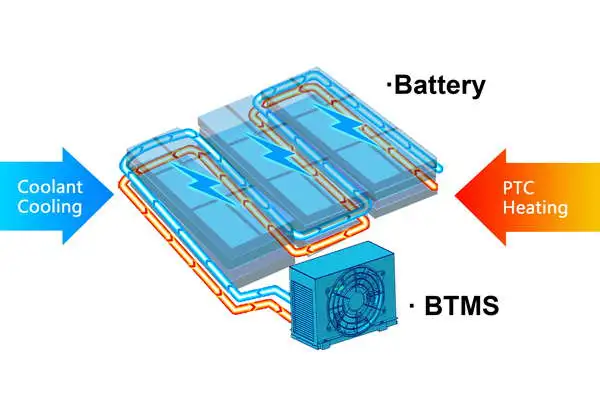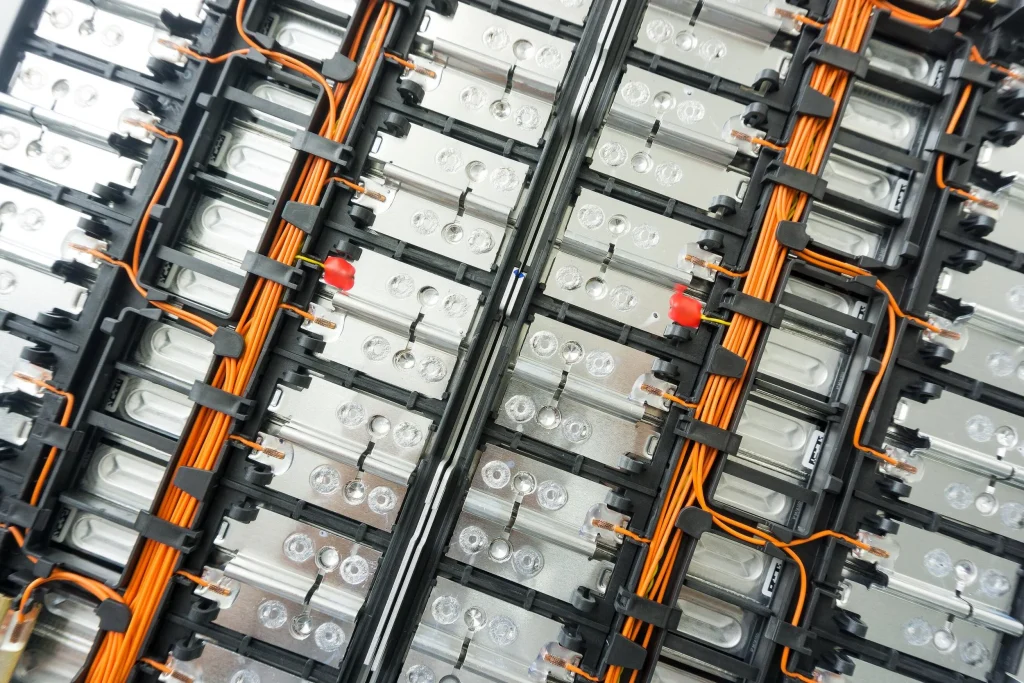An EV battery pack powers your vehicle by combining several key components designed to work seamlessly together. At the heart are the battery cells, the smallest energy units, which come in different types:
- Lithium-ion (NMC): Known for high energy density and longer range but slightly higher cost.
- LFP (Lithium Iron Phosphate): Safer, longer-lasting with better thermal stability, but lower energy density.
These cells are grouped into modules, which provide structure and improve safety. Modules help contain damage if a cell fails and make maintenance easier.
The full battery pack includes these modules housed in a robust enclosure. This enclosure protects against physical damage and environmental factors like water and dust.
Crucial to the pack’s performance is the Battery Management System (BMS). It monitors cell health, voltage, and temperature to ensure safety and efficiency.
To maintain ideal operating conditions, packs feature heating and cooling technology. Thermal management keeps temperatures stable, improving performance, especially in extreme weather.
Together, these components create a powerful, reliable energy source that drives your EV efficiently and safely.
The Anatomy of an EV Battery Pack How It All Fits Together
Building an EV battery pack is a detailed process that starts with raw materials and ends with a fully integrated unit ready for installation in your vehicle. It all begins by sourcing key components like lithium, cobalt, and nickel for the battery cells. These raw materials get transformed into electrodes—anode and cathode layers—which are critical for energy storage.
From there, cells are assembled and grouped into modules. Modules bring multiple cells together, improving safety and making maintenance easier. Then, these modules are combined inside the full battery pack. This pack includes a smart EV battery management system (BMS) to monitor performance and safety.

Image Source:https://www.panorica.com/peugeot/behind-scenes-peugeot-electric-cars-manufacturing
One of the latest innovations is the electrode-to-pack design, which streamlines the battery layout. This innovation helps reduce weight and cost, while improving energy density and cooling efficiency. Instead of building the battery piece by piece, manufacturers now optimize the whole structure at once. That means better range and reliability for drivers.
Finally, the complete battery pack is integrated into the vehicle’s chassis with all the necessary wiring, cooling, and heating technologies to protect it under different driving conditions. This step ensures the battery performs well whether you’re dealing with cold winters in Minnesota or hot summers in Arizona.
Understanding how these pieces fit together gives you a clearer picture of what makes an EV battery pack powerful and reliable on the road.
Performance and Real World Impact Key Metrics That Matter
When looking at an EV battery pack, a few key numbers really stand out for drivers here in the U.S. First up is energy density, which basically tells you how much power the battery holds in a given size. Higher energy density means more miles without adding bulk or weight. For example, typical lithium-ion batteries offer solid range, but newer designs keep pushing those numbers up. This directly affects your electric vehicle range anxiety—the worry about running out of charge before your destination.
Next, consider the vehicle’s charging dynamics and fast charging compatibility. How quickly can your battery go from zero to 80%? Most modern EVs support fast charging, but the speed varies depending on battery chemistry and the onboard EV battery management system (BMS). If you drive in the U.S., where road trips or quick stops are common, fast charging capabilities can make a huge difference.
Temperature matters too. Batteries lose efficiency when it’s really cold. Good battery packs come with built-in heating and cooling tech to keep things stable, improving performance in places like Minnesota winters or chilly Pacific Northwest mornings. Here are some cold weather tips for your EV battery pack:
- Park in a garage or covered area to avoid extreme cold exposure
- Pre-condition your battery using the vehicle’s app before driving
- Limit fast charging in freezing temps to protect battery health
This kind of temperature resilience ensures your EV stays reliable no matter the season, a big deal for U.S. buyers concerned about winter driving conditions.

Image Source: https://www.google.com/Fanalysis-of-innovative-solutions-for-battery-thermal-management-systems/
Performance and Real World Impact Lifespan
When you’re looking at an EV battery pack, lifespan is a big deal. Most electric vehicle batteries last around 8 to 10 years or about 100,000 to 150,000 miles, but this can vary depending on the chemistry and usage. Warranties usually cover 8 years or 100,000 miles, giving a good benchmark for expected durability.
Battery wear isn’t just about mileage. Heat, fast charging habits, and how often you fully charge or deplete the battery all play a role in how the cells degrade. For example, sitting in extreme heat or cold can speed up battery aging, and frequent fast charging puts extra strain on the battery’s chemistry.
Comparing different chemistries, LFP (Lithium Iron Phosphate) batteries tend to degrade slower than NMC (Nickel Manganese Cobalt) packs, meaning they keep more capacity over time. However, LFPs usually have lower energy density, so they might offer slightly less range. NMC batteries offer higher energy density but can lose capacity quicker, especially under heavy use or fast charging.
To sum it up:
- Average EV battery lifespan: 8-10 years or 100,000-150,000 miles
- Warranty coverage: Typically around 8 years/100,000 miles
- Wear factors: Heat, charging habits, depth of discharge, and fast charging
- Chemistry impact: LFP degrades slower but with less range; NMC offers more range but faster degradation
Understanding these factors helps you make smarter choices about your EV battery usage and sets expectations for how long your pack will serve you well.
Cost Maintenance and Upgrades The True Cost of Ownership
When it comes to owning an EV battery pack, understanding the true costs is key. Prices for battery packs have dropped over the years, but replacement costs can still be significant, often ranging from $5,000 to over $15,000 depending on the vehicle and battery size.
Pack Pricing Trends and Replacement Costs
- Prices have declined due to improvements in manufacturing and more competition in the market.
- Larger battery packs—needed for longer range—cost more to replace.
- Replacement isn’t always immediate. Many EVs come with warranties that cover 8 years or around 100,000 miles.
Factors Influencing Cost
- Battery Chemistry: Packs using LFP (Lithium Iron Phosphate) tend to cost less than those with NMC (Nickel Manganese Cobalt), but each has pros and cons to consider.
- Sourcing Materials: Supply chain issues and raw material prices like lithium and cobalt directly impact pack costs.
- Manufacturing Location: Batteries made in the US may be pricier but benefit from local quality control and faster service.
For US drivers, balancing upfront battery costs with long-term savings on fuel and maintenance is important. Staying informed helps make better decisions when it’s time for servicing or upgrading your EV battery pack.

Image Source:https://www.google.com/what-are-ev-batteries-made-of/
Cost Maintenance and Upgrades Maintenance Essentials
Keeping your EV battery pack in top shape means regular maintenance and smart monitoring. Routine checks focus on the battery management system (BMS), which tracks the health and performance of lithium ion battery modules. The BMS alerts you to any imbalances or faults before they become bigger issues, helping avoid costly repairs or premature pack replacement.
Many modern EV battery packs use modular designs, making upgrades and repairs easier. If a module underperforms or ages faster, you can replace or upgrade just that section instead of the entire pack. This modular approach not only saves money but also future-proofs your vehicle as new battery tech becomes available.
On the financial side, take advantage of local incentives and grants aimed at electric vehicle owners. These programs often cover battery pack replacement costs, improvements in battery efficiency, or installation of advanced battery management systems. Staying informed about these can offset some of the typical expenses that come with EV battery pack maintenance and upgrades.
Power Your Future with LEAPENERGY
Ready to power your electric vehicle with cutting-edge battery technology? LEAPENERGY delivers high-performance EV battery packs engineered for superior range, durability, and safety. Our advanced battery solutions are designed to meet the demanding requirements of modern electric and range-extended vehicles.
Whether you’re an automotive manufacturer or fleet operator, we provide customized battery pack solutions that drive innovation forward. Discover how our proven technology can energize your EV projects. Visit our EV/REEV Battery Pack page to explore our complete product lineup, or contact us at leap.hiitio.com to discuss your specific power needs today